Back
A Collection of Essays and Lessons for Junior and Senior High School
Pythagoras' Theorem
Background
Notice how the product of CB and BD is described as "the rectangle CB,BD". This is how the early Pythagoreans understood multiplication - as a physical area (as apart from an abstract product). In modern courses this same explanation would be:
There are many different proofs and demonstrations for this theorem of Pythagoras'. Below is a particularly nice demonstration.
Howard Eves [5] describes the tablet as having three essentially complete columns of figures as reproduced below in figure 2D (only part of the tablet is reproduced here as illustration).
All primitive ( i.e. no common ratio between the three - 6,8,10 is not a primitive triple) Pythagorean triples (a,b,c) are given parametrically by:
Needless to say, if the conclusion made in Eves is correct, then there is evidence of the Pythagorean relationship being known in Babylonia over 1000 years before Pythagoras. Of course no rigorous proof is forthcoming from this period.
Contents
4. Pythagoras' Theorem - origins and proofs
5. Plimpton 322 - Babylonian clay tablet
6. Academic
You might like to do Activity 2 before you continue.
"Certain methods for the discovery of triangles of this kind are handed down, one of which they refer to Plato, the other to Pythagoras. [The latter] starts from odd numbers. For it makes the odd number the smaller of the sides about the right angle; then it makes the square of it, subtracts unity, and makes half the difference the greater of the sides about the right angle; lastly it adds unity to this and so forms the remaining side the hypotenuse. For example, taking 3, squaring it, and subtracting unity from the 9, the method takes half of the 8, namely 4; then, adding unity to it again, it makes 5, and a right-angled triangle has been found…"
This method will yield Pythagorean triples (whole numbers which can form the lengths of a right angled triangle), but it does not yield all triples. It should be seen that the problem of finding Pythagorean triples is to find two square numbers such that their sum is also a square.
One possible way that Pythagoras may have arrived at triples is through the use of the gnomon. The gnomon is the name given to the oblique staff which is used to cast a shadow in the sundial. It is claimed that Anaximander, a contemporary to Pythagoras, introduced the gnomon to Greece from Babylon. As we will see soon,the gnomon became synonymous with the numbers formed by the difference between successive squares - the odds. We know that Pythagoras investigated the figurate numbers and their related patterns. He would possibly have represented the consecutive square numbers 1, 4, 9, 16, 25 as stones grouped as in the figure (figure 2A) below:
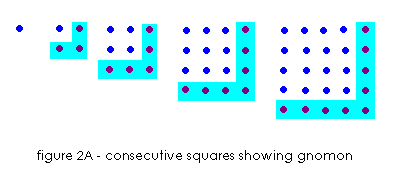
A related, but more abstract and therefore less likely, way that the relationship may have been seen is by writing down three rows of numbers (a) the counting numbers, (b) their squares and (c) the successive odd numbers constituting the difference between the successive squares (figure 2B). By picking out the numbers in the third row which are squares, Pythagoras would have arrived at the same point as above.
figure 2BCounting
Numbers1 2 3
4 5 6 7 8 9
10 11 12 13 14 Squares 1 4 9 16 25 36 49 64 81 100 121 144 169 196 gnomon 3 5 7 9 11 13 15 17 19 21 23 25 27
It is worth noting that neither method would expose the incommensurables (the irrational numbers) and neither is useful as a general proof of the theorem.
"One method is to prove, from the similarity of triangles ABC, DBA, that the rectangle CB,BD is equal to the square on BA, and, from the similarity of the triangles ABC, DAC, that the rectangle BC,CD is equal to the square on CA; whence the result follows from addition" 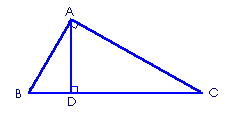
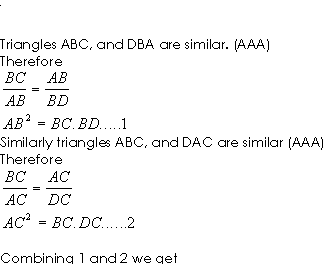
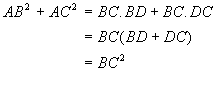
Plimpton 322 (1900 B.C.E. - 1600 B.C.E.)
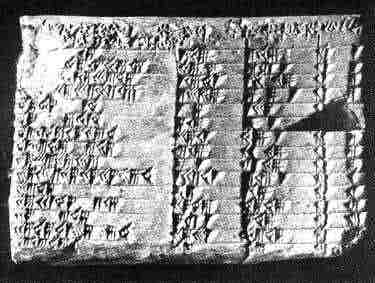
figure 2C
At first glance, when the cuneiform is translated to our numerals, (figure 2D) the table looks like another record of business transactions, stocktaking etc. Analysis however, shows that it has a deep mathematical significance in the theory of numbers.
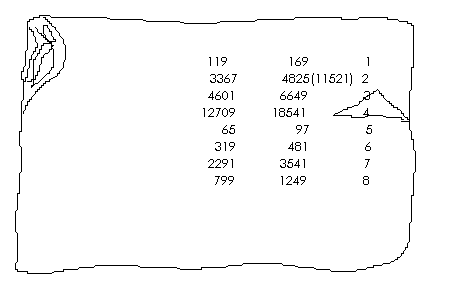
figure 2D
He states that the column on the far right merely numbers each of the lines, and then shows how the other two columns are the hypotenuse and leg of integral-sided right triangles (with a couple of errors - in brackets). He asserts that there is some evidence (considering the properties of the sexagesimal numbers present), to support the view that the Babylonians at this time were aware of the parametric formula for finding the primitive Pythagorean triples.

where u and v are relatively prime, one is odd while the other is even (that is they have different parity), and u > v. Thus if u = 2 and v = 1, we get the primitive triple a = 4, b = 3, c= 5.
Eves then goes on to show how the values on the tablet could have been produced:
a b c u v 120 119 169 12 5 3456 3367 4825 64 27 4800 4601 6649 75 32 13500 12709 18541 125 54 72 65 97 9 4 360 319 481 20 9 2700 2291 3541 54 25 960 799 1249 32 15
References:
[4] Heath, Sir Thomas L., Euclid - The Thirteen Books of The Elements Second Edition Vol i, N.Y.: Dover Publications (orig 1908) On-line version with java applet
[5] Eves, Howard, An Introduction To The History of Mathematics 5th Ed., N.Y.: Saunders College Publishing, 1983
[6] This Essay and the related classroom Activities are on-line at MATHGYM ( http://www.mathtrak.com.au/mic/ )